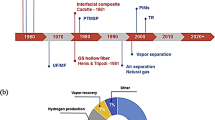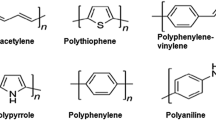Abstract
In-house synthesized monosulfonated para-polybenzimidazole (s-p-PBI) was blended with commercially available disulfonated poly(arylene ether) sulfone (SPAES; SES0105, Aquafone™). The s-p-PBI was prepared from the polycondensation of 2-sulfoterepthalic acid and 3, 3ʹ-diaminobenzidine. The 1H NMR spectroscopy confirms the formation of benzimidazole protons. Copolymer SPAES behaves as the electron-withdrawing polymer (sulfonic groups), and s-p-PBI as the electron-donating polymer (imidazole groups). The interactions between polymers are examined through Attenuated Total Reflectance-Fourier Transformed Infrared spectroscopy (ATR-FTIR), Thermogravimetric Analysis (TGA), and Scanning Electron Microscopy (SEM). Tensile stress at maximum load of blend membrane containing 80% (w/w) of s-p-PBI and 20% (w/w) of SPAES (AM-AC-80) is 55.59 MPa, whereas pristine s-p-PBI (AM-AC-100) membrane is 45.35 MPa. The blend polymers were stable in boiling water. All the blend membranes were morphologically stable at 1500 ppm of NaOCl solution immersed for 24 h except for pristine s-p-PBI. The blend polymers showed improved tensile strength and stability in NaOCl solutions compared to pristine s-p-PBI. The blend membranes displayed improved salt rejection with decreasing water permeability. The intrinsic parameters for desalination performance were examined to correlate crosslinking with water and salt transport. AM-AC-80 shows a slight improvement in water diffusivity and a four-fold increase in permeability selectivity (water/NaCl) compared to pristine s-p-PBI.










Similar content being viewed by others
Change history
06 September 2022
A Correction to this paper has been published: https://doi.org/10.1007/s00289-022-04452-3
References
Chen D, Yu S, Zhang H, Li X (2015) Solvent resistant nanofiltration membrane based on polybenzimidazole. Sep Purif Technol 142:299–306. https://doi.org/10.1016/j.seppur.2015.01.011
Mader JA, Benicewicz BC (2010) Sulfonated polybenzimidazoles for high temperature PEM fuel cells. Macromolecule 43:6705–6715. https://doi.org/10.1021/ma1009098
Wang X, Jayaweera P, Alrasheed RA, Aljlil SA, Alyousef YM, Alsubaei M, Alromaih H, Jayaweera I (2018) Preparation of polybenzimidazole hollow-fiber membranes for reverse osmosis and nanofiltration by changing the spinning air gap. Membranes 8:113. https://doi.org/10.3390/membranes8040113
Borjigin H, Stevens KA, Liu R, Moon JD, Shaver AT, Swinnea S, Freeman BD, Riffle JS, McGrath JE (2015) Synthesis and characterization of polybenzimidazoles derived from tetraaminodiphenylsulfone for high temperature gas separation membranes. Polymer 71:135–142. https://doi.org/10.1016/j.polymer.2015.06.021
Aiba M, Tokuyama T, Matsumoto H, Tomioka H, Higashihara T, Ueda M (2015) Effect of primary structure on permselectivity of ultrathin semipermeable polybenzimidazole membrane. J Appl Polym Sci 41531:1–7. https://doi.org/10.1002/app.41531
Aiba M, Tokuyama T, Matsumoto H, Tomioka H, Higashihara T, Ueda M (2016) Semipermeable membranes based on polybenzimidazole: simultaneous improvement in water flux and salt rejection by facile crosslinking. Desalination 395:1–7. https://doi.org/10.1016/j.desal.2016.05.021
Wang KY, Chung TS, Rajagopalan R (2007) Novel polybenzimidazole (PBI) nanofiltration membranes for the separation of sulfate and chromate from high alkalinity brine to facilitate the chlor-alkali process. Ind Eng Chem Res 46:1572–1577. https://doi.org/10.1021/ie061435j
Daer S, Akther N, Wei Q, Shon HK, Hasan SW (2020) Influence of silica nanoparticles on the desalination performance of forward osmosis polybenzimidazole membranes. Desalination 49:114441. https://doi.org/10.1016/j.desal.2020.114441
Valtcheva IB, Kumbharkar SC, Kim JF, Bhole Y, Livingston AG (2014) Beyond polyimide: Crosslinked polybenzimidazole membranes for organic solvent nanofiltration (OSN) in harsh environments. J Memb Sci 457:62–72. https://doi.org/10.1016/j.memsci.2013.12.069
Glater J, Hong SK, Elimelech M (1994) The search for a chlorine-resistant reverse osmosis membrane. Desalination 95(3):325–345. https://doi.org/10.1016/0011-9164(94)00068-9
Verbeke R, Gómez V, Vankelecom IFJ (2017) Chlorine-resistance of reverse osmosis (RO) polyamide membranes. Prog Polym Sci 72:1–15. https://doi.org/10.1016/j.progpolymsci.2017.05.003
Yi C, Wang Z, Li M, Wang J, Wang S (2006) Facilitated transport of CO2 through polyvinylamine/polyethlene glycol blend membranes. Desalination 193:90–96. https://doi.org/10.1016/j.desal.2005.04.139
Won M, Kwon S, Kim TH (2015) High performance blend membranes based on sulfonated poly(arylene ether sulfone) and poly(p-benzimidazole) for PEMFC applications. J. Ind. Eng. Chem 29:104–111. https://doi.org/10.1016/j.jiec.2015.03.022
Zhao C, Xue J, Ran F, Sun S (2013) Modification of polyethersulfone membranes-a review of methods. Prog Mater Sci 58:76–150. https://doi.org/10.1016/j.pmatsci.2012.07.002
Kim YJ, Lee KS, Jeong MH, Lee JS (2011) Highly chlorine-resistant end-group crosslinked sulfonated-fluorinated poly(arylene ether) for reverse osmosis membrane. J Memb Sci 378:512–519. https://doi.org/10.1016/j.memsci.2011.05.040
Lee CH, McCloskey BD, Cook J, Lane O, Xie W, Freeman BD, Lee YM, McGrath JE (2012) Disulfonated poly(arylene ether sulfone) random copolymer thin film composite membrane fabricated using a benign solvent for reverse osmosis applications. J Memb Sci 23:1039–1049. https://doi.org/10.1016/j.memsci.2011.11.001
Xie W, Cook J, Park HB, Freeman BD, Lee CH, McGrath JE (2011) Fundamental salt and water transport properties in directly copolymerized disulfonated poly(arylene ether sulfone) random copolymers. Polymer 52:2032–2043. https://doi.org/10.1016/j.polymer.2011.02.006
Feng S, Shang Y, Wang S, Xie X, Wang Y, Wang Y, Xu J (2010) Novel method for the preparation of ionically crosslinked sulfonated poly (arylene ether sulfone )/ polybenzimidazole composite membranes via in situ polymerization. J Memb Sci 346:105–112. https://doi.org/10.1016/j.memsci.2009.09.026
Hong YT, Lee CH, Park HS, Min KA, Kim HJ, Nam SY, Lee YM (2008) Improvement of electrochemical performances of sulfonated poly(arylene ether sulfone) via incorporation of sulfonated poly(arylene ether benzimidazole). J Power Sour 175:724–731. https://doi.org/10.1016/j.jpowsour.2007.09.068
Matindi CN, Hu M, Kadanyo S, Ly QV, Gumbi NN, Dlamini DS, Li J, Hu Y, Cui Z, Li J (2021) Tailoring the morphology of polyethersulfone/sulfonated polysulfone ultrafiltration membranes for highly efficient separation of oil-in-water emulsions using TiO2 nanoparticles. J Memb Sci 620:118868. https://doi.org/10.1016/j.memsci.2020.118868
Bagheri A, Salarizadeh P, Hazer MSA, Hosseinabadi P, Kashefi S, Beydaghi H (2019) The effect of adding sulfonated SiO2 nanoparticles and polymer blending on properties and performance of sulfonated poly ether sulfone membrane: Fabrication and optimization. Electrochimica Acta 295:875–890. https://doi.org/10.1016/j.electacta.2018.10.197
Xie W, Park HB, Cook J, Lee CH, Byun G, Freeman BD, McGrath JE (2010) Advances in membrane materials: Desalination membranes based on directly copolymerized disulfonated poly(arylene ether sulfone) random copolymers. Water Sci Technol 61:619–624. https://doi.org/10.2166/wst.2010.883
Zhang S, Guan S, Liu C, Wang Z, Wang D, Jian X (2019) Effect of chemical structure on the performance of sulfonated poly(aryl ether sulfone) composite nanofiltration membranes. Membranes 9(6):1–12. https://doi.org/10.3390/membranes9010006
Roy S, Lane O, Kazerooni D, Narang GS, Soung E (2019) Synthesis and characterization of post-sulfonated poly ( arylene ether sulfone ) membranes for potential applications in water desalination Synthesis and characterization of post-sulfonated poly(arylene ether sulfone ) membranes for potential applicatio. Polymer 177:250–261. https://doi.org/10.1016/j.polymer.2019.05.075
Liu Y, Yue X, Zhang S, Ren J, Yang L, Wang Q, Wang G (2012) Synthesis of sulfonated polyphenylsulfone as candidates for antifouling ultrafiltration membrane. Sep Purif Technol 98:298–307. https://doi.org/10.1016/j.seppur.2012.06.031
Di Vona ML, Sgreccia E, Tamilvanan M, Khadhraoui M, Chassigneux C, Knauth P (2010) High ionic exchange capacity polyphenylsulfone (SPPSU) and polyethersulfone (SPES) crosslinked by annealing treatment: thermal stability, hydration level and mechanical properties. J Memb Sci 354:134–141. https://doi.org/10.1016/j.memsci.2010.02.058
Hasiotis C, Deimede V, Kontoyannis C (2001) New polymer electrolytes based on blends of sulfonated polysulfones with polybenzimidazole. Electrochimica Acta 46(15):2401–2406. https://doi.org/10.1016/S0013-4686(01)00437-6
Asadi Tashvigh A, Luo L, Chung TS, Weber M, Maletzko C (2018) Performance enhancement in organic solvent nanofiltration by double crosslinking technique using sulfonated polyphenylsulfone (sPPSU) and polybenzimidazole (PBI). J Memb Sci 551:204–213. https://doi.org/10.1016/j.memsci.2018.01.047
Thomas OD, Peckham TJ, Thanganathan U, Yang Y, Holdcroft S (2010) Sulfonated polybenzimidazoles: proton conduction and acid-base crosslinking. J Polym Sci Part A Polym Chem 48:3640–3650. https://doi.org/10.1002/pola.24147
Geise GM, Paul DR, Freeman BD (2014) Fundamental water and salt transport properties of polymeric materials. Prog Polym Sci 39:1–42. https://doi.org/10.1016/j.progpolymsci.2013.07.001
Krishnan NN, Lee HJ, Kim HJ, Kim JY, Hwang I, Jang JH, Cho EA, Kim SK, Henkensmeier D, Hong SA, Lim TH (2010) Sulfonated poly(ether sulfone)/sulfonated polybenzimidazole blend membrane for fuel cell applications. Eur Polym J 46:1633–1641. https://doi.org/10.1016/j.eurpolymj.2010.03.005
Bai H, Ho WW (2009) New carbon dioxide-selective membranes based on sulfonated polybenzimidazole (SPBI) copolymer matrix for fuel cell applications. Ind Eng Chem Res 48(5):2344–2354. https://doi.org/10.1021/ie800507r
Valtcheva IB, Kumbharkar SC, Kim JF, Bhole Y, Livingston AG (2014) Beyond polyimide: crosslinked polybenzimidazole membranes for organic solvent nanofiltration (OSN) in harsh environments. J Membr Sci 457:62–72. https://doi.org/10.1016/j.memsci.2013.12.069
Pan H, Chen S, Jin M, Chang Z, Pu H (2017) Preparation and properties of sulfonated polybenzimidazole-polyimide block copolymers as electrolyte membranes. Ionics 24:6861. https://doi.org/10.1007/s11581-017-2341-1
Han J, Kim K, Kim J, Kim S, Choi SW, Lee H, Kim JJ, Kim TH, Sung YE, Lee JC (2019) Cross-linked highly sulfonated poly(arylene ether sulfone) membranes prepared by in-situ casting and thiol-ene click reaction for fuel cell application. J Membr Sci 1(579):70–8. https://doi.org/10.1016/j.memsci.2019.02.048
Ismail AF, Khuble KC, Matsuura T (2019) RO Membrane Preparation (ed) Reverse Osmosis pp.25–56 https://doi.org/10.1016/B978-0-12-811468-1.00002-5
Wienk IM, Boom RM, Beerlage MAM, Bulte AMW, Smolders CA, Strathmann H (1996) Recent advances in the formation of phase inversion membranes made from amorphous or semi-crystalline polymers. J Membr Sci 113(2):361–371. https://doi.org/10.1016/0376-7388(95)00256-1
Franceschini EA, Corti HR (2009) Elastic properties of Nafion, polybenzimidazole and poly [2,5-benzimidazole] membranes determined by AFM tip nano-indentation. J Power Sources 188:379–386. https://doi.org/10.1016/j.jpowsour.2008.12.019
Feng P, Liu Z, Liu S, Li X, Hu W, Jiang Z, Liu B (2013) Novel sulfonated poly(ether ether ketone)/polybenzimidazole blends for proton exchange membranes, High Perform. Polym 25:697–704. https://doi.org/10.1177/0954008313482956
Wang S, Zhang G, Han M, Li H, Zhang Y, Ni J, Ma W, Li M, Wang J, Liu Z, Zhang L, Na H (2011) Novel epoxy-based crosslinked polybenzimidazole for high temperature proton exchange membrane fuel cells. Int J Hydrogen Energy 36:8412–8421. https://doi.org/10.1016/j.ijhydene.2011.03.147
Geise GM, Lee HS, Miller DJ, Freeman BD, McGrath JE, Paul DR (2010) Water purification by membranes: the role of polymer science. J Polym Sci Part B Polym Phys 48:1685–1718. https://doi.org/10.1002/polb.22037
Mohan S, Sundaraganesan N, Mink J (1991) FTIR and Raman studies on benzimidazole. Spectrochim Acta Part A Mol Spectrosc 47:1111–1115. https://doi.org/10.1016/0584-8539(91)80042-H
Hu L, You M, Meng J (2021) Chlorination as a simple but effective method to improve the water / salt selectivity of polybenzimidazole for desalination membrane applications. J Memb Sci 638:119745. https://doi.org/10.1016/j.memsci.2021.119745
Park HB, Freeman BD, Zhang Z-B, Sankir M, McGrath JE (2008) Highly Chlorine-Tolerant Polymers for Desalination. Angew Chemie 120:6108–6113. https://doi.org/10.1002/ange.200800454
Afonso MD, de Pinho MN (2000) Transport of MgSO4, MgCl2, and Na2SO4 across an amphoteric nanofiltration membrane. J Membr Sci 179(1–2):137–154. https://doi.org/10.1016/S0376-7388(00)00495-6
Acknowledgements
We would gratefully acknowledge Dr. Santanu Karan, Senior Scientist from the Council of Scientific and Industrial Research-Central Salt and Marine Chemicals Research Institute (CSIR-CSMCRI) Bhavnagar (India), for conducting desalination measurements for our synthesized and casted membranes in his laboratory.
Funding
This work was funded by the Department of Science of Technology-Science and Engineering Research Board (DST-SERB), Government of India [Grant number ECR/2015/000014].
Author information
Authors and Affiliations
Contributions
Material preparation, data collection, characterization, and analysis were performed by KR Venkatachalam and SGM Balasundaram. The first draft of the manuscript was written by KR Venkatachalam. JN Krishnan performed early conception and approved the final manuscript.
Corresponding author
Ethics declarations
Conflict of interest
The authors declare that they have no conflict of interest.
Additional information
Publisher's Note
Springer Nature remains neutral with regard to jurisdictional claims in published maps and institutional affiliations.
Rights and permissions
Springer Nature or its licensor holds exclusive rights to this article under a publishing agreement with the author(s) or other rightsholder(s); author self-archiving of the accepted manuscript version of this article is solely governed by the terms of such publishing agreement and applicable law.
About this article
Cite this article
Venkatachalam, K.R., Gautham, S.M.B. & Nambi Krishnan, J.N. Desalination characteristics of new blend membranes based on sulfonated polybenzimidazole and sulfonated poly(arylene ether sulfone). Polym. Bull. 80, 7805–7824 (2023). https://doi.org/10.1007/s00289-022-04428-3
Received:
Revised:
Accepted:
Published:
Issue Date:
DOI: https://doi.org/10.1007/s00289-022-04428-3




